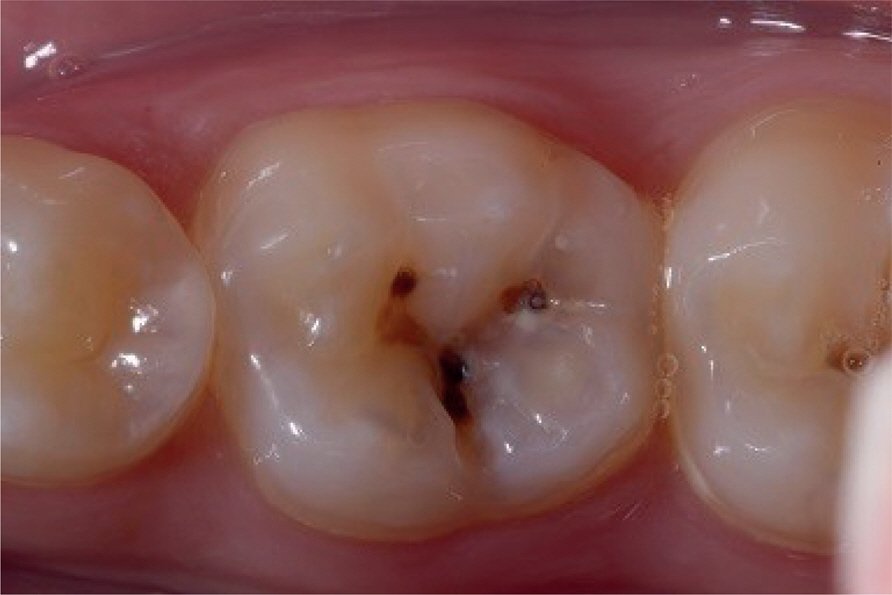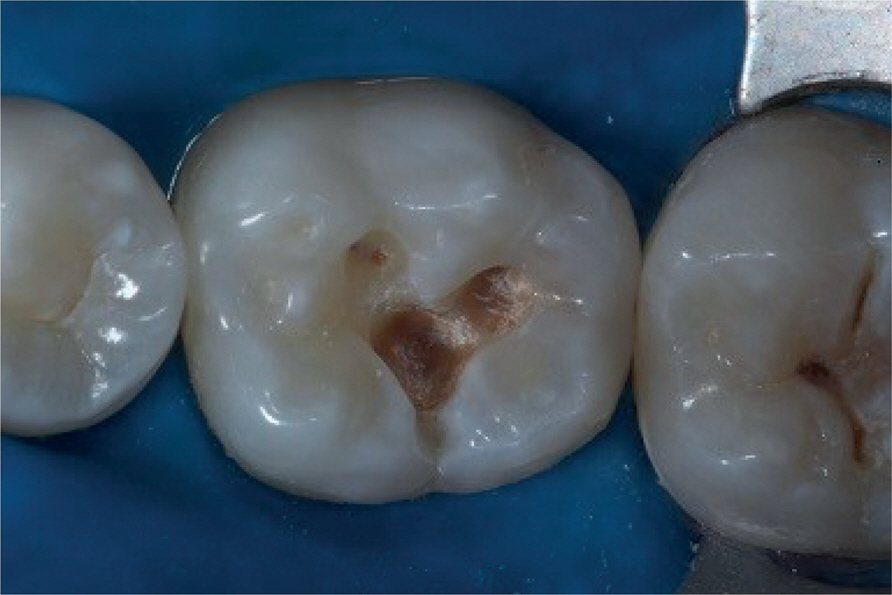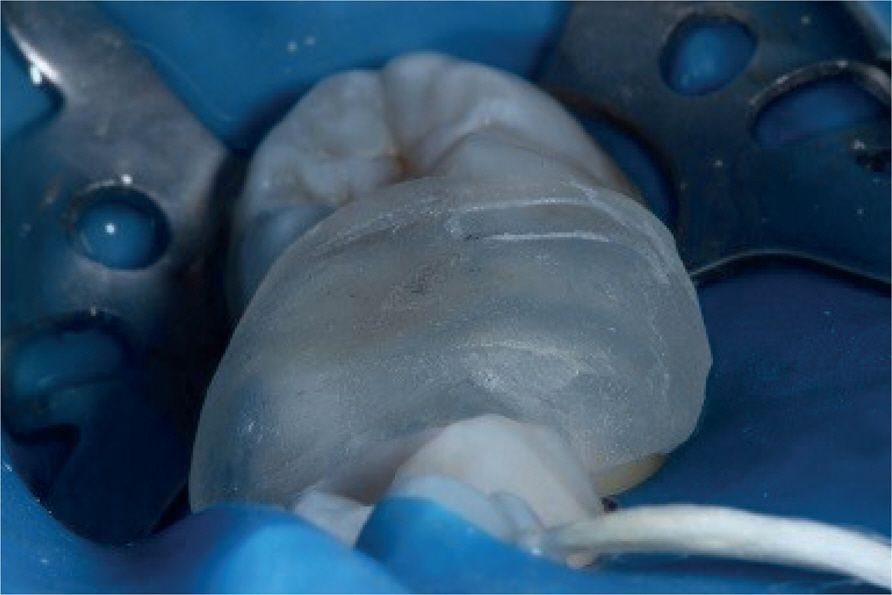Restor Dent Endod.
2020 Feb;45(1):e9. 10.5395/rde.2020.45.e9.
Functional and aesthetic rehabilitation in posterior tooth with bulk-fill resin composite and occlusal matrix
- Affiliations
-
- 1Department of Operative Dentistry, School of Dentistry, University of São Paulo, São Paulo, SP, Brazil.
- 2Program in Dentistry, Department of Dentistry, Federal University of Sergipe, Aracaju, SE, Brazil. flavia_odonto@hotmail.com
- 3Department of Dentistry, Federal University of Sergipe, Aracaju, SE, Brazil.
- KMID: 2470344
- DOI: http://doi.org/10.5395/rde.2020.45.e9
Abstract
- The restorative procedure in posterior teeth involves clinical steps related to professional skill, especially when using the incremental technique, which may fail in the long term. A recent alternative is bulk-fill resins, which can reduce polymerization shrinkage, decreasing clinical problems such as marginal leakage, secondary caries, and fracture. This scientific study aims to report a clinical case using bulk-fill resin with an occlusal matrix. As determined in the treatment plan, an acrylic resin matrix was produced to establish an improved oral and aesthetic rehabilitation of the right mandibular first molar, which presented a carious lesion with dentin involvement. The occlusal matrix is a simple technique that maintains the original dental anatomy, showing satisfactory results regarding function and aesthetic rehabilitation.
Keyword
MeSH Terms
Figure
Reference
-
References
1. Richards D. Oral diseases affect some 3.9 billion people. Evid Based Dent. 2013; 14:35.
Article2. Demarco FF, Corrêa MB, Cenci MS, Moraes RR, Opdam NJ. Longevity of posterior composite restorations: not only a matter of materials. Dent Mater. 2012; 28:87–101.
Article3. Laegreid T, Gjerdet NR, Johansson A, Johansson AK. Clinical decision making on extensive molar restorations. Oper Dent. 2014; 39:E231–E240.
Article4. Yazici AR, Antonson SA, Kutuk ZB, Ergin E. Thirty-six-month clinical comparison of bulk fill and nanofill composite restorations. Oper Dent. 2017; 42:478–485.
Article5. Costa T, Rezende M, Sakamoto A, Bittencourt B, Dalzochio P, Loguercio AD, Reis A. Influence of adhesive type and placement technique on postoperative sensitivity in posterior composite restorations. Oper Dent. 2017; 42:143–154.
Article6. van Dijken JW, Pallesen U. A randomized controlled three year evaluation of “bulk-filled” posterior resin restorations based on stress decreasing resin technology. Dent Mater. 2014; 30:e245–e251.
Article7. Margeas RC. Bulk-fill materials: simplify restorations, reduce chairtime. Compend Contin Educ Dent. 2015; 36:e1–e4.8. Zorzin J, Maier E, Harre S, Fey T, Belli R, Lohbauer U, Petschelt A, Taschner M. Bulk-fill resin composites: polymerization properties and extended light curing. Dent Mater. 2015; 31:293–301.
Article9. Ilie N, Bucuta S, Draenert M. Bulk-fill resin-based composites: an in vitro assessment of their mechanical performance. Oper Dent. 2013; 38:618–625.
Article10. Alshali RZ, Silikas N, Satterthwaite JD. Degree of conversion of bulk-fill compared to conventional resin-composites at two time intervals. Dent Mater. 2013; 29:e213–e217.
Article11. El-Damanhoury H, Platt J. Polymerization shrinkage stress kinetics and related properties of bulk-fill resin composites. Oper Dent. 2014; 39:374–382.
Article12. Olegário IC, Hesse D, Bönecker M, Imparato JC, Braga MM, Mendes FM, Raggio DP. Effectiveness of conventional treatment using bulk-fill composite resin versus Atraumatic Restorative Treatments in primary and permanent dentition: a pragmatic randomized clinical trial. BMC Oral Health. 2016; 17:34.
Article13. Braz R, Mergulhão VA, Oliveira LR, Alves MS, Canto CA. Flared roots reinforced with bulk-fill flowable composite-case report. Oper Dent. 2018; 43:225–231.14. Alqudaihi FS, Cook NB, Diefenderfer KE, Bottino MC, Platt JÁ. Comparison of internal adaptation of bulk-fill and increment-fill resin composite materials. Oper Dent. 2019; 44:E32–E44.
Article15. Ammannato R, Rondoni D, Ferraris F. Update on the ‘index technique'in worn dentition: a no-prep restorative approach with a digital workflow. Int J Esthet Dent. 2018; 13:516–537.16. Veloso SR, Lemos CA, de Moraes SL, do Egito Vasconcelos BC, Pellizzer EP, de Melo Monteiro GQ. Clinical performance of bulk-fill and conventional resin composite restorations in posterior teeth: a systematic review and meta-analysis. Clin Oral Investig. 2019; 23:221–233.
Article17. Maghaireh GA, Price RB, Abdo N, Taha NA, Alzraikat H. Effect of thickness on light transmission and Vickers hardness of five bulk-fill resin-based composites using polywave and single-peak light-emitting diode curing lights. Oper Dent. 2019; 44:96–107.
Article18. Tauböck TT, Jäger F, Attin T. Polymerization shrinkage and shrinkage force kinetics of high- and low-viscosity dimethacrylate- and ormocer-based bulk-fill resin composites. Odontology. 2019; 107:103–110.
Article19. Kruly PC, Giannini M, Pascotto RC, Tokubo LM, Suga US, Marques AC, Terada RS. Meta-analysis of the clinical behavior of posterior direct resin restorations: low polymerization shrinkage resin in comparison to methacrylate composite resin. PLoS One. 2018; 13:e0191942.
Article20. AlSagob EI, Bardwell DN, Ali AO, Khayat SG, Stark PC. Comparison of microleakage between bulk-fill flowable and nanofilled resin-based composites. Interv Med Appl Sci. 2018; 10:102–109.
Article
- Full Text Links
- Actions
-
Cited
- CITED
-
- Close
- Share
- Similar articles
-
- Color Stability of Bulk-Fill Resin Composites after Immersion in Different Media
- Clinical performance of class I cavities restored with bulk fill composite at a 1-year follow-up using the FDI criteria: a randomized clinical trial
- Color evaluation of low viscosity bulk-fill resin with composite resin capping layer
- Comparison of Surface Microhardness of the Flowable Bulk-Fill Resin and the Packable Bulk-Fill Resin according to Light Curing Time and Distance
- Effect of resin thickness on the microhardness and optical properties of bulk-fill resin composites








